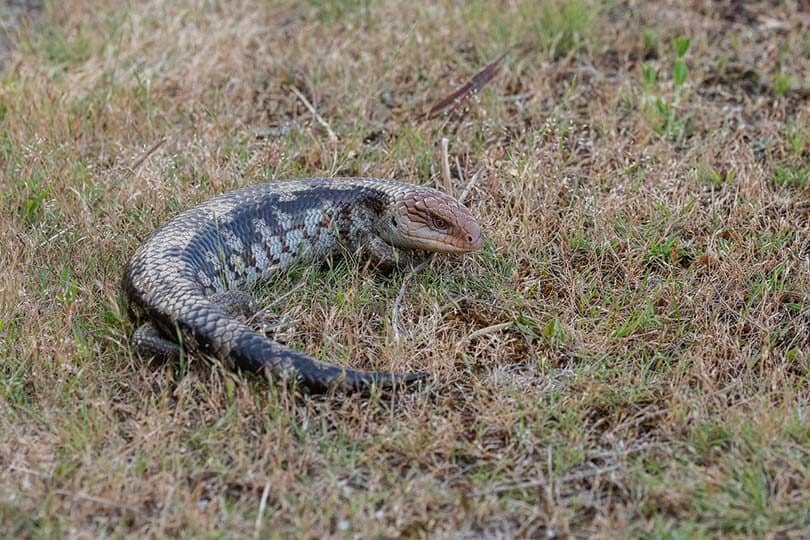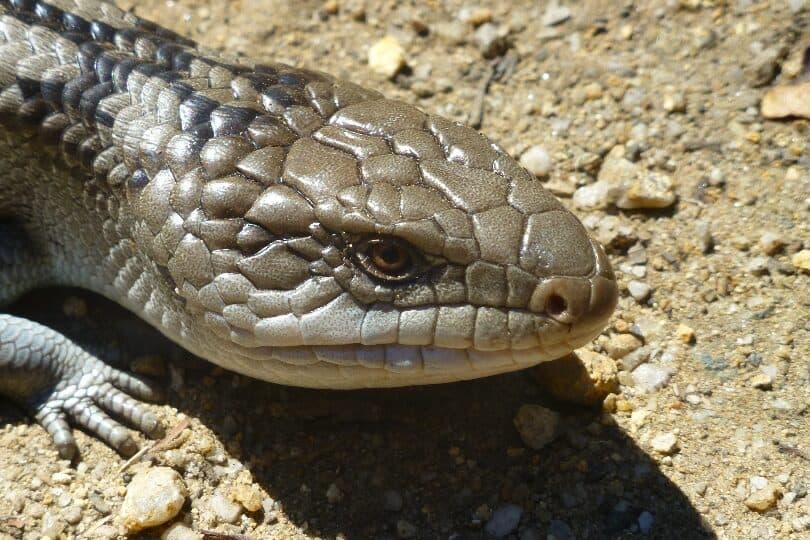Blue-Tongued Skink: Facts, Info & Care Guide (With Pictures)
By admin / December 16, 2022 / No Comments / Pet Dogs
This article goes in-depth on the appropriate blue-tongued skink care and will inform you on the top tips and tricks to keeping these beautiful creatures healthy and happy in captivity.
Quick Facts about Blue-Tongued Skinks

| Species Name: | Tiliqua scincoides intermedia |
| Common Name: | Northern blue tongue skink |
| Care Level: | Moderately difficult |
| Lifespan: | 15 – 20 years |
| Adult Size: | 18 – 24 inches |
| Diet: | Omnivores |
| Minimum Tank Size: | 40-gallon breeder tank |
| Temperature & Humidity: | 75°F – 82°F 60% – 80% humidity |
Do Blue-Tongued Skinks Make Good Pets?
Blue tongue skinks are friendly and intelligent. They tolerate human interaction and can take a liking to be handled. They are good-sized lizards to hold and rarely show signs of aggression if they have been tamed from a young age. They are hypoallergenic and make good pets for beginners and seasoned reptile owners alike. They are better suited to teenagers or adults and are too delicate and complicated for small children. The cost and maintenance are low with pet blue tongue skinks.
Appearance
Blue tongue skinks get quite large and grow to an adult size between 18 to 24 inches. Their body is silver-grey to brown and the scales are shiny and smooth. The underbelly of the blue tongue skink is a light grey color. The body is sturdier with a broad triangular head that widens more than the neck. Females and males look alike, and both have dark brown bands. They come in two main color forms, namely mottled and variegated.
How to Take Care of a Blue-Tongued Skink

Habitat, Tank Conditions & Setup
Tank
The minimum tank size for an adult blue tongue skink is a 40-gallon breeder. The tank should have more length than height. Baby blue tongue skinks can use a 20-gallon as a grow-out tank. They prefer a naturalistic enclosure full of plants, hideouts, and a shallow dish of fresh, clean water. The tank should be regularly cleaned, and waste should be removed. Leftover food should be removed from the tank after a few hours.
Lighting
A UVB light is recommended for blue tongue skinks. The bulb should also provide UVA, and both are important for proper absorption of Vitamin D3. The lights should be kept on between 10 to 12 hours a day and turned off at night. The bulb should be full-spectrum and reptile safe.
Heating (Temperature & Humidity)
Blue tongue skinks regulate their body temperature through thermoregulation. This makes it important to have both a warm and cool end of the habitat. One end of the tank should have heating equipment, and the other side should be left cool and a few degrees cooler than the warm side. A thermometer should be placed on both sides of the tank so that it can be effectively monitored. The temperature should be between 80°F to 88°F. The cooler side should be between 68°F to 72°F. Humidity should be maintained between 60% to 80%.
Substrate
Blue tongue skinks can be housed on many different types of substrates. Aspen, fir bark, and cypress mulch are some of the best substrates for a blue tongue skinks habitat. The habitat should be layered with logs, branches, and rocks to replicate its natural environment. The decorations should be sparse as blue tongue skinks require large open spaces to comfortably move around.
| Tank Recommendations | |
| Tank Type | 40-gallon breeder tank |
| Lighting | UVB and UVA bulb |
| Heating | Heating pad |
| Best Substrate | Aspen bedding |
Feeding Your Blue-Tongued Skink
These reptiles are omnivores and should be fed a combination of vegetables, protein, and fruit. The blue tongue skinks diet should be kept varied and plentiful. If you feed canned reptile foods, ensure you feed different brands and types to ensure that the blue tongue skink gets all the nutrients it needs to be healthy. A Vitamin D3 calcium supplement is an important addition to their diet and should be sprinkled over their food. Calcium is most important for young blue tongue skinks, but adults require it at least three times a week.
Adult blue tongue skinks should be fed every two to three days. The food bowl should be large enough that the food does not catch on the substrate as this can cause impactions.
- Dry/canned dog food
- Canned insects
- Cooked chicken
- Cooked turkey (grounded)
- Lean beef (cooked)
- Pinky mice
- Turnip greens
- Mustard greens
- Collard greens
- Mango
- Papaya
- Figs
- Raspberries
- Strawberries
| Diet Summary | |
| Fruits | 10% of the diet |
| Insects | 40% of the diet |
| Meat | 50% of the diet |
| Supplements Required | Vitamin D3 calcium powder |
Keeping Your Blue-Tongued Skink Healthy
Clean water should be accessible in a shallow dish created for reptiles. They are not good swimmers and can drown if they cannot get out of the water bowl. Blue tongue skinks should have enough humidity to avoid illnesses like respiratory distress or bacterial infections caused by a damp environment. A hydrometer should be used to measure the amount of humidity in the tank. They require time to settle into their new environment and should not be handled during this time.
- Mouth rot: This is an infection of the mouth and gums. It is caused by stress, dirty conditions, and frequent soft foods.
- Sloughing: This is an issue with shedding if the environment is not humid enough.
- Internal parasites: This can be introduced into the body through contaminated food, substrate, or parasites from other pets.
- Raw nose: This is caused by the blue tongue skink rubbing their nose on rough surfaces.
- Respiratory infections: Inadequate conditions and a constant cool and damp environment causes respiratory issues.
Lifespan
The blue tongue skink can live for two decades under good care. It is not uncommon for them to live for 30 years if the conditions allow it. The average lifespan of the blue tongue skink is between 15 to 20 years. Their lifespan is shortened by illness or poor care in terms of habitat, heating, calcium intake, and diet.

Breeding
It is quite challenging to breed blue tongue skinks and many advanced keepers struggle. The female should be at least 2 years of age before breeding, and the male over 1 year. Blue tongue skinks successfully breed, you need to introduce them to each other after a period of brumation. After which they will mate several times. The female gives birth three to five months after mating and it is generally between December and February.
Are Blue-Tongued Skinks Friendly? Our Handling Advice
Tame blue tongue skinks are friendly and easy to handle if you do it correctly. When handling them, you should take care to support their body by placing it along your forearm and holding it on the side so that they do not jump or fall out of your arms. Blue tongue skinks should be tamed as babies to ensure they are friendly and comfortable being handled as they get older. Avoid handling your blue tongue skink if it seems overly stressed.

Shedding & Brumation: What to Expect
Blue tongue skinks brumate when their instincts allow them to. You should never force your skink to brumate in captivity as this can do more harm than good. They naturally brumate in the winter months and will sleep for longer. The blue tongue skink sheds a few times a week when they are very young, and it evens out as they mature. Once they reach adulthood, they typically shed a few times a month.
How Much Do Blue-Tongued Skinks Cost?
The Northern blue tongue skink can cost anywhere between $150 to $250 depending on where you purchase them from. Exotic pet stores generally charge less for a blue tongue skink, whereas breeders have better quality stock and will charge more. Babies and cheaper than full-grown adult blue tongue skinks. They are affordable long-term, but the initial cost of caging, supplies, and food can run from $500 to $900. The rare types of pet skinks can cost between $1,500 to $4,000 each.

Care Guide Summary
- Friendly nature
- Inquisitive and exploratory
- Easy to handle
- Prone to serious illnesses
- Needs time to adjust to a new environment
- Get stressed easily
Conclusion
The blue tongue skink is an interesting pet that many owners claim to feel a strong bond too. Since they live for such a long time, you should be prepared to care for these reptiles for a couple of decades. Ensuring that they have the best habitat, and a healthy diet will lessen your blue tongues skink chances of falling ill. With proper care, these are very rewarding pets.
Featured Image Credit: JJ Harrison, Wikimedia Commons CC SA 3.0 Unported (Tiliqua scincoides scincoides)
